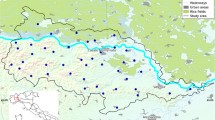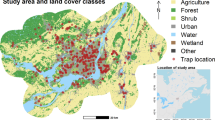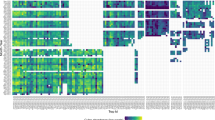Abstract
Culex quinquefasciatus is the main vector of West Nile Virus (WNV) in the southeast USA, and inter-annual variation in this vector abundance is mainly related to meteorological variability. In this study, short-term effects of meteorological conditions on seasonal variation in the vector abundance in the central north part of the State of Georgia, USA, from 2002 to 2009 were assessed. Four weeks moving average temperature, precipitation, potential evapotranspiration, and available moisture in the surface layer of soil were considered as risk factors. Cross-correlation maps were developed to investigate influences of preceding environmental conditions during a time-lagged interval on mosquito count data. The Poisson regression model and Artificial Neural Network (ANN) model were used for prediction purposes. Two sets of predictors were used: (1) the interval lagged climate data with the highest correlation and (2) single time lag antecedent Culex mosquito abundance up to 10 weeks prior to the events combined with lagged climate data. Results revealed that both models predicted the seasonal cycle of vector abundance fairly accurately, with ANN performing better than the regression model. The addition of antecedent mosquito data as input improved the prediction power of both models. The developed predictive models can be helpful in informed decision-making when high WNV activities are anticipated.






Similar content being viewed by others
References
ArboNET, Arboviral Diseases Branch, Centers for Disease Control and Prevention (2019) https://www.cdc.gov/mosquitoes/mosquito-control/professionals/ArboNET.html. Accessed Mar 2020
Andreadis TG (2012) The contribution of Culex pipens complex mosquitoes to transmission and persistence of West Nile Virus in North America. J Am Mosq Control Assoc 28(4 Suppl):137–151. https://doi.org/10.2987/8756-971X-28.4s.137
Roiz D, Ruiz S, Soriguer R, Figuerola J (2014) Climatic effects on mosquito abundance in Mediterranean wetlands. Parasit Vectors 7:1–13
Paull SH, Horton DE, Ashfaq M, Rastogi D, Kramer LD, Diffenbaugh NS, Kilpatrick AM (2017) Drought and immunity determine the intensity of West Nile virus epidemics and climate change impacts. Proc R Soc B 284:20162078. https://doi.org/10.1098/rspb.2016.2078
Mordecai EA, Caldwell JM, Grossman K (2019) Thermal biology of mosquito-borne disease. Ecol Let 2(10):1690–1708. https://doi.org/10.1111/ele.13335
Strickman D (1988) Rate of oviposition by Culex Quinquafasciatus in San Antonio, Texas, during three years. J Am Mosq Control Assoc 4(3):339–344
Rey JR (2011) The mosquito ENY-727 (IN652), one of a series of the Entomology and Nematology Department, Florida Cooperative Extension Service, Institute of Food and Agricultural Sciences, University of Florida
American Mosquito Control Association (2014) http://www.mosquito.org/
Curriero FC, Shone SM, Glass GE (2005) Cross correlation maps: a tool for visualizing and modeling time lagged associations. Vector-Borne Zoonotic Dis 5:267–275
Reisen W, Fang Y, Martinez VM (2006) Effects of temperature on the transmission of West Nile Virus by Culex tarsalis (Diptera: Culicidae). J Med Entomol 43:309–317
Dohm DJ, O’Guinn ML, Turel MJ (2002) Effect of environmental temperature on the ability of Culex pipiens (Diptera: Culicidae) to transmit West Nile virus. J Med Entomol 39:221–225
Epstein PR (2001) West Nile Virus and the climate. J Urban Health Bull N Y Acad Med 78(2):367–371. https://doi.org/10.1093/jurban/78.2.367
Patz JA, Olson SH, Uejio ChK, Gibbs HK (2008) Disease emergence from global climate and land use change. Med Clin N Am 92:1473–1491
Wang G, Minnis RB, Belant JR, Wax ChR (2010) Dry weather induces outbreaks of human West Nile virus infections. BMC Infect Dis 10:1–7
Day JF (2001) Predicting St. Louis encephhalitis virus epidemics: lessons from recent, and not so recent. Outbreaks Annu Rev Entomol 46:111–138
Shaman J, Stieglitz M, Stark C, Blancq SL, Cane M (2002) Using a dynamic hydrology model to predict mosquito abundances in flood and swamp water. Emerg Infect Dis 8:6–13
Soverow JE, Wellenius GA, Fisman DE, Mittleman MA (2009) Infectious disease in a warming world: how weather influenced west nile virus in the United States (2001–2005). Environ Health Perspect 117:1049–1052
Ruiz MO, Chaves LF, Hamer GL, Sun T et al (2010) Local impact of temperature and precipitation on West Nile virus infection in Culex species mosquitoes in northeast Illinois, USA. Parasit Vectors 3:1–16
Shaman J, Day JF, Stieglitz M (2005) Drought-induced amplification and epidemic transmission of West Nile Virus in Southern Florida. J Med Entomol 42:134–141
Day J, Shaman J (2008) Using hydrologic conditions to forecast the risk of focal and epidemic arboviral transmission in Peninsular Florida. J Med Entomol 45:458–465
Wang J, Ogden NH, Zhu H (2011) The impact of weather conditions on Culex pipiens and Culex restuans (Diptera: Culicidae) abundance: a case Study in Peel Region. J Med Entomol 48:468–475
Walsh AS, Glass GE, Lesser CR, Curriero FC (2008) Predicting seasonal abundance of mosquitoes based on off-season meteorological conditions. Environ Ecol Stat 15:279–291
Ahumada JA, Lapointe D, Samuel MD (2004) Modeling the population dynamics of Culex quinquefasciatus (Diptera: Culicidae), along an elevational gradient in Hawaii. J Med Entomol 41:1157–1170
Gong H, DeGaetano A, Harrington LC (2007) A climate based mosquito population model. In: Proceedings of the world congress on engineering and computer science, October 24–26, San Francisco, USA
Morin CW, Comrie AC (2010) Modeled response to the West Nile virus vector Culex quinquefasciatus to changing climate using the dynamic mosquito simulation model. Int J Biometeorol 54:517–529
Shone SM, Curriero FC, Lesser CR, Glass GE (2006) Characterizing population dynamics of aedes sollicitans (diptera: culicidae) using meteorological data. J Med Entomol 43:393–402
Chuang TW, Ionides EL, Knepper RG, Stanuszek WW, Walker ED, Wilson ML (2012) Cross-correlation map analyses show weather variation influences on mosquito abundance patterns in Saginaw County, Michigan, 1989–2005. J Med Entomol 49:851–858
Lebl K, Brugger K, Rubel F (2013) Predicting Culex pipiens/restuans population dynamics by interval lagged weather data. Parasit Vectors 6:1–11
Huang J, Huug M, Dool VD, Georgakakos KP (1996) Analysis of model-calculated soil moisture over the United States (1931–93) and application to long-range temperature forecasts. J Climate 9(6):1350
Van den Dool H, Huang J, Fan Y (2003) Performance and analysis of the constructed analogue method applied to US soil moisture over 1981–2001. J Geophys Res 108:1–12
Thornthwaite CW (1948) An approach toward a rational classification of climate. Geogr Rev 38:55–94
Vazquez-Prokopec GM, Vanden Eng JL, Kelly R, Mead DG, Kolhe P, Howgate J, Kitron U, Burkot TR (2010) The risk of west nile virus infection is associated with combined sewer overflow streams in urban Atlanta, Georgia, USA. Environ Health Persp 118:1382–1388
Silver JB (2008) Sampling adults with light-traps. In: Mosquito ecology: field sampling methods, Springer, New York, pp 845–946
Reiter P (1983) A portable, battery-powered trap for collecting gravid Culex mosquitoes. Mosq News 43(4):496–498
Stoddard ST, Wearing HJ, Reiner RC Jr et al (2014) Long-term and seasonal dynamics of Dengue in Iquitos. Peru PLoS Negl Trop Dis 8:1–15
R Core Team (2013) R: a language and environment for statistical computing. Reference Index. R Foundation for Statistical Computing, Vienna, Austria. Version 3.0.1
Dawson CW, Wilby RL (2001) Hydrologic modeling using artificial neural networks. Progs Phys Geogr 25:80–108
Kalin L, Isik S, Schoonover JE, Lockaby BG (2010) Predicting water quality in unmonitored watersheds using artificial neural networks. J Environ Qual 39:1429–1440
Rezaeian Zadeh M, Amin S, Khalili D, Singh VP (2010) Daily outflow prediction by multi layer perceptron with logistic sigmoid and tangent sigmoid activation functions. Water Resour Manage 24:2673–2688
Nash JE, Sutcliff JV (1970) River flow forecasting through conceptual models, part I: a discussion of principles. J Hydrol 10:282–290
Salas JD, Markus M, Tokar AS (2000) Streamflow forecasting based on artificial neural networks. In: Artificial neural networks in hydrology, Water Science and Technology Library, vol 36, Springer, pp 23–51
Morin CW, Comrie AC (2013) Regional and seasonal response of a West Nile virus vector to climate change. PNAS 110:15620–15625
Rosa R, Marini G, Bolzoni L, Neteler M et al (2014) Early warning of West Nile virus mosquito vector: climate and land use models successfully explain phenology and abundance of Culex pipiens mosquitoes in north-western Italy. Parasit Vectors 7:1–12
Harrigan RJ, Thomassen HA, Buermann W, Smith ThB (2014) A continental risk assessment of West Nile virus under climate change. Glob Change Biol 20:2417–2425
Acknowledgements
We gratefully acknowledge the Southeast Cooperative Wildlife Disease Study (SCWDS) at the College of Veterinary Medicine at University of Georgia, Athens, for providing the mosquito data.
Funding
This project is funded by USDA Forest Service, National Urban & Community Forestry Council and Center for Environmental Studies at the Urban–Rural Interface, School of Forestry and Wildlife Sciences, Auburn University.
Author information
Authors and Affiliations
Corresponding author
Ethics declarations
Competing interests
The authors declare that they have no known competing financial interests or personal relationships that could have appeared to influence the work reported in this paper.
Additional information
Publisher's Note
Springer Nature remains neutral with regard to jurisdictional claims in published maps and institutional affiliations.
Rights and permissions
About this article
Cite this article
Noori, N., Kalin, L., Lockaby, B.G. et al. Short-term prediction of Culex quinquefasciatus abundance in Central North Georgia, USA, based on the meteorological variability. Neural Comput & Applic 34, 14717–14728 (2022). https://doi.org/10.1007/s00521-022-07324-z
Received:
Accepted:
Published:
Issue Date:
DOI: https://doi.org/10.1007/s00521-022-07324-z




